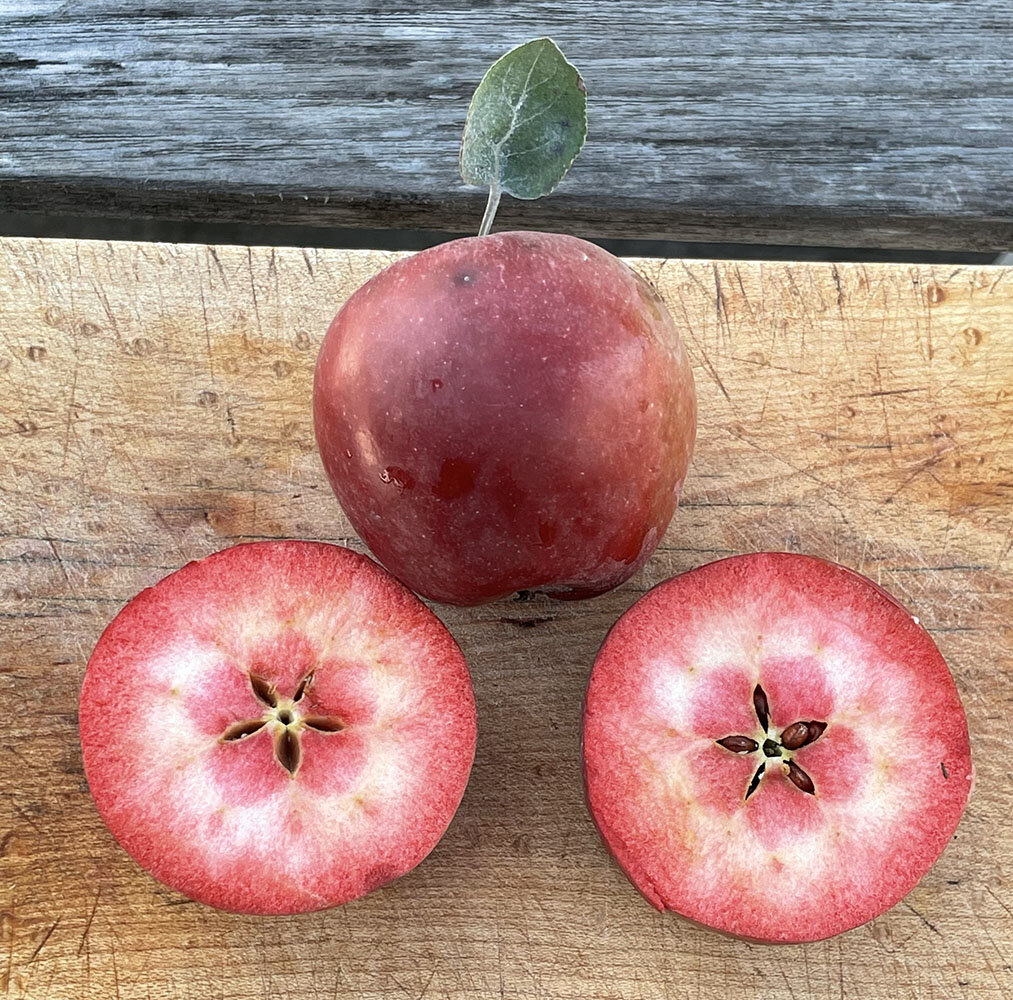Update from a 2017 blog post.
When I moved to Old Frog Pond Farm, rows of Red Delicious apples grew in the back of orchard. An apple mentor told me our pick-your-own customers would not be interested in these apples. I could either pull the trees and replant—a lot of work, or topwork these trees—keep the trunk and roots and grow another variety on top. I preferred the latter.
To topwork an apple tree, you need scion wood—small twigs of first-year growth cut in winter from a dormant apple tree. I attended a scion wood exchange where I grabbed a twig of the Almata apple along with several other varieties that were spread across an old pool table. I chose Almata because it was named after one of the largest cities in Kazakhstan. Almaty means “full of apples” and sits against the foothills of the Tian Shan Mountains, the forests that are the birthplace of the apple we eat today. Returning home with my scion wood I grafted a number of Red Delicious tree. On one of them I grafted the Almata wood.
Scion wood in Red Delicious Trunk
The scion wood inserted all around the trunk grew, and three years later, this tree developed its first flower buds. Apple blossom buds are usually enrobed in a pink sheath, which then open to pale white flower petals. The Almata buds weren’t pink, but dark red, like the scarlet letter stitched on Hester Prynne’s chest in Nathaniel Hawthorne’s novel. Four days later, when the orchard was a cloud of white petals, this tree’s blossoms opened to a lovely pink. When the leaves came in, they were not green but a bronzy color similar to some crab apples. After pollination, its dime-sized apples were dark red, not green, like every other apple in the orchard.
Reddish Leaves on the Almata
All summer long I kept my eye on this tree. Friends walking with me through the orchard would remark, “What’s that?” pointing to the Almata. It was easy to see that this tree was marked. The apples were quite small, but perfectly formed and deep red. In mid-August, I stopped by the Almata to taste one of its fruits. My large bite of apple exposed red-colored flesh. It was crazy and wonderful, and all wrong. It didn’t look like an apple at all, but more like a plum. It was hard and sour, not yet ripe.
Charmed, I hurried back to the house to share my discovery with my family. I looked up Almata and learned that this red-fleshed apple was developed by Dr. Nels Hansen at the South Dakota Agricultural Experiment Station. Dr. Hansen was inspired to breed a red-fleshed eating apple after seeing a red-fleshed wild apple on an 1897 trip to Russia. The Almata is the cross he made between a Russian apple, the Beautiful Arcade and Fluke 38, a crabapple.
Almata apple cut open on August 6, 2021
When I showed this apple to my partner, Blase, he said, “It looks like a mandala.”
Yesterday I noticed that a root stock I had let grow without grafting a variety on it had fruited. To my surprise, when I took a bite, it, too, was red-fleshed, and bitter!
Apple from Bud 9 rootstock
I’ve cooked Almatas in an apple galette. The Almata wove lovely red ribbons through the mound of white apples—it held its color even when cooked. When I made a Russian apple cake, I was again delighted by the flowing red slices of the Almata. Although some people say that the fruit of the Tree of Knowledge of Good and Evil was actually a pomegranate, I disagree. I can imagine the serpent winding around a branch, tempting Eve with a ripe, red-fleshed apple. With only one tree, we don’t have a lot Almata apples, but if you can’t resist cutting one open for yourself, our limited crop is available at the farm stand.
















